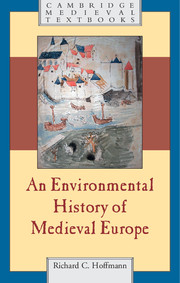Book contents
- Frontmatter
- Contents
- List of figures
- List of maps
- Preface
- Frontispiece: Nature and culture at Waterford, Ireland, 1372
- Introduction: Thinking about medieval Europeans in their natural world
- 1 Long no wilderness
- 2 Intersecting instabilities: culture and nature at medieval beginnings, c.400–900
- 3 Humankind and God’s Creation in medieval minds
- 4 Medieval land use and the formation of traditional European landscapes
- 5 Medieval use, management, and sustainability of local ecosystems, 1: primary biological production sectors
- 6 Medieval Use, management, and sustainability of local ecosystems, 2: interactions with the non-living environment
- 7 ‘This belongs to me . . .’
- 8 Suffering the uncomprehended: disease as a natural agent
- 9 An inconstant planet, seen and unseen, under foot and overhead
- 10 A slow end of medieval environmental relations
- Afterword
- A sampler for further reading
- Index
- References
10 - A slow end of medieval environmental relations
Published online by Cambridge University Press: 05 July 2014
- Frontmatter
- Contents
- List of figures
- List of maps
- Preface
- Frontispiece: Nature and culture at Waterford, Ireland, 1372
- Introduction: Thinking about medieval Europeans in their natural world
- 1 Long no wilderness
- 2 Intersecting instabilities: culture and nature at medieval beginnings, c.400–900
- 3 Humankind and God’s Creation in medieval minds
- 4 Medieval land use and the formation of traditional European landscapes
- 5 Medieval use, management, and sustainability of local ecosystems, 1: primary biological production sectors
- 6 Medieval Use, management, and sustainability of local ecosystems, 2: interactions with the non-living environment
- 7 ‘This belongs to me . . .’
- 8 Suffering the uncomprehended: disease as a natural agent
- 9 An inconstant planet, seen and unseen, under foot and overhead
- 10 A slow end of medieval environmental relations
- Afterword
- A sampler for further reading
- Index
- References
Summary
When is the end to an environmental history of medieval Europe? If the protracted transformation of late antiquity marked the advent of a new cultural entity with its own characteristic, if not all distinctive, ways of interacting with natural forces in a certain part of the earth’s surface, what makes a comparable conclusion to this story? When it comes to periodization, multiple historical discourses, climatological, economic, sociological, epidemiological, cultural, and more, commonly talk past one another at best, each displaying its typical reductionism and determinism. Multiple perspectives on natural and cultural evolutions show autonomous and interactive changes playing out from the fourteenth century into the sixteenth.
Ecological crisis? Anthropogenic overshoot, slow chill, sudden natural shock
As just seen, climate in the form of the Little Ice Age and disease as manifest in the Black Death do provide bold historical markers with immediate effects in the curtailing of primary production and seasonal human activities and the magnitude of human deaths. Do these identify the end of the Middle Ages in environmental terms? Simple quantitative relationships of Europeans to their surroundings were surely recalibrated. Having reached some 75–80 million around 1300, their numbers fell by 30–60 per cent in the twenty years between the mid-1340s, which Christian Pfister has called the worst climatic conditions of the past millennium in central Europe, and the mid-1360s, with what the same expert has described as the coldest winter of the second millennium. At macrocosmic and microcosmic scales these rapidly catastrophic mid-fourteenth-century events invite juxtaposition with the climatic downturn associated with the ‘dry fog’ of 536 and the Justinianic plague of 540, both with centuries of alleged after-effects. Natural cataclysms appeal to audiences and writers who enjoy a past simply forged by natural forces.
- Type
- Chapter
- Information
- An Environmental History of Medieval Europe , pp. 342 - 370Publisher: Cambridge University PressPrint publication year: 2014



